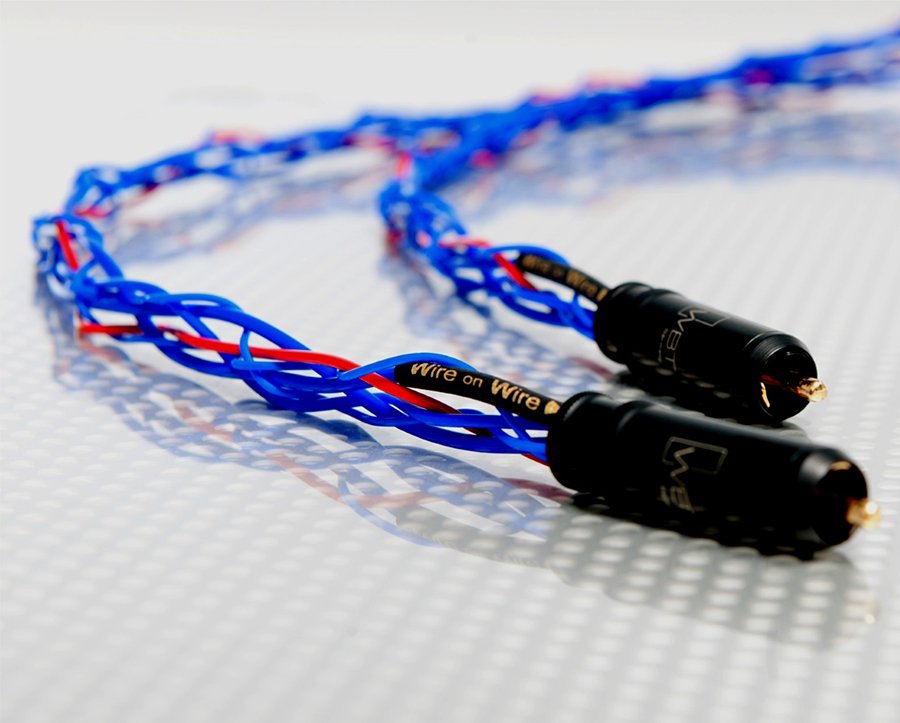The £280/m Experience 680 interconnect from British manufacturer Wire On Wire is an interesting concept in that is able to be ‘tuned’ by the owner. Dominic Marsh tunes in for Hifi Pig.
When you have had as many cables through your hands as I have, it takes something either exceptional or really off the wall to get my immediate attention and this Wire On Wire interconnect certainly did that when I first opened the packaging. 
Wire On Wire kindly sent me two cables to evaluate, one that was “naked” without any spacers and another with the full complement of adjustment variables having all the spacers installed. At first look it looks like something a drunk spider has fabricated after a generous glug of some home brew with what appears at first sight to be a haphazard weave pattern, but look past that and you find a cable that obviously has a great deal of attention paid to its construction. Any idiot can do a simple three strand plait weave blindfolded, but this cable is a lot more complex than that and according to the designer Chris Bell it took an inordinate amount of research and experiment to arrive at this final design. The resultant geometry is called “REDpurl” and I understand that a patent has been applied for and is pending (GB1602578.5).
Most of us will (hopefully) know that resistance, capacitance and inductance are all traits inherent in any speaker or interconnect cable and whilst resistance remains fairly constant dependant on wire metallurgy, tamper with capacitance parameters and inductance falls victim to that and vice versa. Some designers rely on those two parameters to shape the final sound, but it is fixed once the cable is manufactured into the final product. Wire On Wire decided that there was an opportunity to manipulate these parameters in their favour and also allow the end user to do likewise by a simple yet ingenious method of adding or subtracting spacers to vary the geometry of the weave pattern. These spacers are not introduced randomly; they are allocated at predetermined intervals or “nodes” along the length of the cable.
Construction
Wire On Wire have chosen silver plated copper conductors despite this configuration having a reputation for having a sharp edgy treble performance, but that is mostly earned by cheap silver plated copper wires and many leading cable manufacturers also use this combination of silver plating and copper core to good effect, so that reputation is rather too generalist, applied with a very broad brush and perhaps not applicable to all silver plated copper wires. Although not actually measured, the conductors themselves appear to be of different diameters, some with a red outer insulating jacket to preserve polarity for termination. Insulation is by PTFE. Capacitance is quoted at 69pF per metre which of course is variable depending upon spacer configuration.
The cable is fitted with good quality and genuine WBT- 0114 RCA locking connectors.
There is the option to have the cable covered in an expandable outer mesh sleeving.
Price is £280.00 for 1 metre pair at time of testing, with other lengths available to order.
Sound
I spent a considerable amount of time familiarising myself with the sonic qualities of the cable without the tuning spacers, before delving into adding/subtracting the spacers to tune the sound. I am fortunate that my latest CD player acquisition has two line level outputs so comparing cables with instant A/B switching by source selection on my pre-amp makes comparisons so much easier, although I still prefer using my ears as the arbiter.
To put it mildly, I was stunned at how good the “naked” Wire On Wire cable sounded when put head-to-head against my resident interconnect cable which has a price tag of £2,000. Yes there were differences in presentation but they were fractional and as a result, very subtle and had to be critically listened for.
Into the CD drawer went Fink’s “Wheels Beneath My Feet” live album and that has many cues that puts any Hifi components through their paces for me. The first is the ambiences recorded at each venue of Fink’s European tour, where each has its own unique reverberation and of course, each audience too has its own signature in the way they cheer and applaud the performance. I would expect to hear each as unique and the Wire On Wire cable performed this with ease, so you could easily tell the volume of each theatre by that ambience. Imaging, width and depth very good, with steady instrument placement in the sounstage. Bass however was just a fraction behind my resident cable and didn’t quite have the power and energy, nor did the Wire On Wire cable muster the sheer definition and shape of bass notes the resident cable can portray down in the lowest registers. Midband was equally as clear and lucid, male and female voices too for that matter was certainly on a par between the two cables. Put into context then, the Wire On Wire cable at £280.00 fared very well against a £2,000 cable and there wasn’t much outclassing going on unless one is being hyper critical. I went through most of my CD collection over a period of two weeks and then I felt the time was right to introduce the full ‘spacered’ up variant of the Experience 680 interconnect.
The sound to me was a chasm away from what I heard from the “naked” cable; a tad thick sounding and bloated in the bass, the treble to me had lost its polish and refinement and the midband acquired a chesty quality, so it shows just how critical conductor geometry spacing is with this cable, indeed with all cables. Thankfully, Wire On Wire provide a handbook that shows how to tune the cable by subtracting and adding their plastic spacers to the cable, the nodes being numbered and counted off from the source end, no matter which way round the cable is initially installed.
Above is a chart copied from Wire On Wire’s website explaining the effects of adding or removing the spacers has on the perceived sound. Being the thick idiot that I am, whenever I took a spacer out I placed a square of masking tape onto the loop the spacer was removed from so I would know the exact place it came from. The combinations and permutations of spacers installed or not runs into the thousands as Chris Bell pointed out to me, so it would be rather unwise and indeed pointless typing out the results that I got during the evaluation, as in all probability none would match those obtained by buyers of this cable in their own systems and of course meeting their own listening preferences. What I can tell you is all the changes were subtle rather than manifested in clearly obvious amounts.
CONCLUSION
Wire On Wire’s website has an anecdote about Chris Bell’s cable which says their product HAS to sound good or the man will be locked in the shed until it does.
In the final analysis, I much preferred the “naked” variant above the cable that had the spacers installed, no matter what combination and permutation of spacers I took out and put in with my current system as it stands. Readers should not be concerned by this statement as I am more than certain your results would probably be at complete variance with mine anyway. To me the spacers were an optional extra and of course the price remains the same with or without the spacers so that is a good value proposition for the asking price. Obviously the planets were aligned just right for the unmolested cable to sound just right for my system and I don’t know whether that is a good or bad thing for the purpose of this review and I make no apologies if you wanted a full autopsy of my many spacer swapping trials, but I still went back again and again to the sans spacer cable.
However, being the inveterate box swapper that I am, there might come the day that the spacers become an essential tool in tuning the sound to my personal tastes when one of my myriad of blind purchases has an acute attack on ‘non-synergy’ when introduced into my system – as has happened in the past. At that precise moment it would be comforting to know that I have to hand an easy method of accomplishing that fine sonic tailoring instead of hunting around for a completely new cable to match, so the Wire On Wire Experience 680’s versatility and adaptability earns my recommendation.
Build Quality: At first glance it looks a right tangle and a bit fragile, but looks are deceptive in this case. The inclusion of good quality and genuine WBT connectors is a welcome sign.
Sound Quality: Gave a pair of £2k high end interconnects a surprisingly good challenge. Says it all.
Value For Money: I rated it well without the spacers installed, but the day might come when they earn their keep with their tuneable options as the spacers adds no additional purchase cost.
Pros: Great quality sound with the ability to be customised to your own listening tastes. At £280 a metre it represents good value too.
Cons: Not the prettiest cable around. If it bothers you then an outer mesh sleeve is available.
Price: £280/m
Dominic Marsh



















































































































































































































You must be logged in to leave a reply.